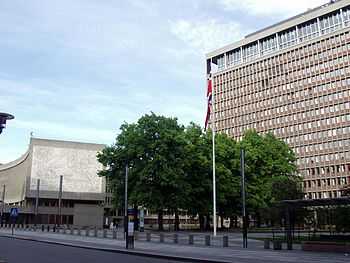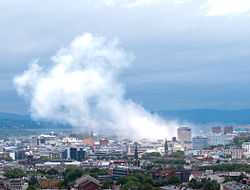Regjeringskvartalet
Coordinates: 59°54′54″N 10°44′45″E / 59.91500°N 10.74583°E

On the left: The Y-block
On the right: Høyblokken.
Note: picture taken before the 2011 bombing.
Regjeringskvartalet (the Government quarter) is a collection of buildings in the centre of Norwegian capital city Oslo housing several of the offices of the Government of Norway. The complex is around 300 m northeast of the Parliament Building.
Overview
Regjeringskvartalet consists of the following buildings:
- Akersgata 40 (G-block) from 1905, the first phase of development from the original plan; now the Ministry of Finance.
- Akersgata 42 (Høyblokken, "the Highrise") from 1958, designed by Erling Viksjø in the modernist style; now the Office of the Prime Minister and the Ministry of Justice and the Police.
- Akersgata 44 (Y-block), from 1969, another modernis building by Erling Viksjø; now the Ministry of Education and Research.
- Akersgata 59 (R5)—departementsgården from 1996 designed by Torstein Ramberg; houses the Ministry of Transport and Communications, the Ministry of Culture, the Ministry of Agriculture and Food, the Ministry of Government Administration, Reform and Church Affairs, the Ministry of Local Government and Regional Development, and the Ministry of Children, Equality and Social Inclusion.
- Einar Gerhardsens plass 1 (R4); houses the Ministry of Petroleum and Energy and the Ministry of Trade and Industry.
- Einar Gerhardsens plass 3 and Møllergata 19 (S-block); houses the Ministry of Health and Care Services and the Ministry of Labour.
The Government Administration Services, centred in Møllergata 19, provides administrative services to other Government departments. Statsbygg manages the buildings on behalf of the Norwegian state, and is responsible for running and maintaining Regjeringskvartalet.
At Teatergata 9, a new building, R6, is scheduled for completion in 2012. The 16 storey building will house the Ministry of Health and Care Services and the Ministry of Agriculture and Food.[1]
Several buildings in Regjeringskvartalet were heavily damaged when a car bomb exploded on 22 July 2011, resulting in 8 deaths.
Art
Between the late 1950s and the early 1970s, artist Pablo Picasso made sketches for his first five first monumental concrete murals to be executed on the buildings’ interiors and exteriors. The largest, The Fisherman (1970), is installed on the façade of Y-block. Norwegian artists Inger Sitter, Kai Fjell and Carl Nesjar, among others, also made works for the buildings. When the government considered whether to demolish the buildings after the 2011 attacks, the Norwegian Directorate for Cultural Heritage expressed its fears that Picasso’s murals for two of them may be destroyed.[2]
-

Møllergata 19, a part of the S-block
-

Map of Regjeringskvartalet
-

Regjeringskvartalet after the 22 July 2011 bombing
References
- ↑ "Veidekke bygger nytt regjeringsbygg", Stein Jarle Olsen, Teknisk Ukeblad, 20 May 2009
- ↑ Clemens Bomsdorf (January 14, 2013), Picasso murals under threat The Art Newspaper.
External links
![]() Media related to Regjeringskvartalet at Wikimedia Commons
Media related to Regjeringskvartalet at Wikimedia Commons